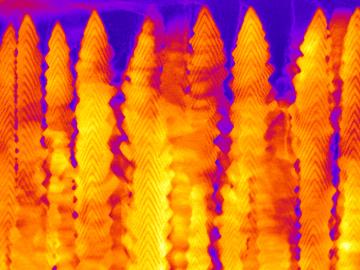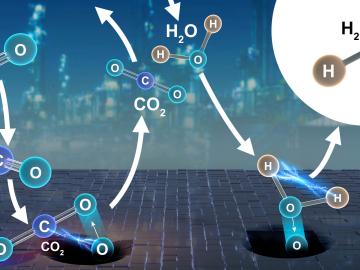
Filter News
Area of Research
- (-) Biology and Environment (13)
- (-) Materials (38)
- (-) Nuclear Science and Technology (13)
- Advanced Manufacturing (4)
- Computational Engineering (1)
- Computer Science (5)
- Electricity and Smart Grid (1)
- Energy Science (52)
- Fuel Cycle Science and Technology (1)
- Functional Materials for Energy (1)
- Fusion and Fission (13)
- Fusion Energy (1)
- Isotope Development and Production (1)
- Isotopes (8)
- Materials for Computing (6)
- National Security (16)
- Neutron Science (47)
- Quantum information Science (2)
- Supercomputing (51)
News Type
News Topics
- (-) Artificial Intelligence (6)
- (-) Computer Science (13)
- (-) Grid (4)
- (-) Isotopes (6)
- (-) Neutron Science (24)
- (-) Nuclear Energy (12)
- 3-D Printing/Advanced Manufacturing (17)
- Advanced Reactors (5)
- Big Data (1)
- Bioenergy (14)
- Biology (18)
- Biomedical (6)
- Biotechnology (5)
- Buildings (3)
- Chemical Sciences (21)
- Composites (4)
- Coronavirus (7)
- Critical Materials (8)
- Cybersecurity (5)
- Energy Storage (21)
- Environment (20)
- Exascale Computing (1)
- Frontier (3)
- Fusion (4)
- High-Performance Computing (8)
- Irradiation (1)
- ITER (1)
- Machine Learning (4)
- Materials (46)
- Materials Science (40)
- Microscopy (14)
- Molten Salt (2)
- Nanotechnology (22)
- National Security (3)
- Partnerships (10)
- Physics (15)
- Polymers (6)
- Quantum Computing (1)
- Quantum Science (10)
- Security (1)
- Simulation (5)
- Space Exploration (2)
- Summit (4)
- Transportation (5)
Media Contacts

Juergen Rapp, a distinguished R&D staff scientist in ORNL’s Fusion Energy Division in the Nuclear Science and Engineering Directorate, has been named a fellow of the American Nuclear Society

A team led by the Department of Energy’s Oak Ridge National Laboratory synthesized a tiny structure with high surface area and discovered how its unique architecture drives ions across interfaces to transport energy or information.

Researchers at the Department of Energy’s Oak Ridge National Laboratory are refining their design of a 3D-printed nuclear reactor core, scaling up the additive manufacturing process necessary to build it, and developing methods

Researchers at the Department of Energy’s Oak Ridge National Laboratory have used Summit, the world’s most powerful and smartest supercomputer, to identify 77 small-molecule drug compounds that might warrant further study in the fight

OAK RIDGE, Tenn., Feb. 19, 2020 — The U.S. Department of Energy’s Oak Ridge National Laboratory and the Tennessee Valley Authority have signed a memorandum of understanding to evaluate a new generation of flexible, cost-effective advanced nuclear reactors.

Energy storage startup SPARKZ Inc. has exclusively licensed five battery technologies from the Department of Energy’s Oak Ridge National Laboratory designed to eliminate cobalt metal in lithium-ion batteries. The advancement is aimed at accelerating the production of electric vehicles and energy storage solutions for the power grid.

An international team of researchers has discovered the hydrogen atoms in a metal hydride material are much more tightly spaced than had been predicted for decades — a feature that could possibly facilitate superconductivity at or near room temperature and pressure.

Researchers at the Department of Energy’s Oak Ridge National Laboratory have received five 2019 R&D 100 Awards, increasing the lab’s total to 221 since the award’s inception in 1963.

Quanex Building Products has signed a non-exclusive agreement to license a method to produce insulating material from ORNL. The low-cost material can be used as an additive to increase thermal insulation performance and improve energy efficiency when applied to a variety of building products.

Collaborators at the Department of Energy’s Oak Ridge National Laboratory and U.S. universities used neutron scattering and other advanced characterization techniques to study how a prominent catalyst enables the “water-gas shift” reaction to purify and generate hydrogen at industrial scale.


